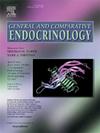Age-related changes in fecal adrenal androgen levels in hylobatids
IF 1.7
3区 医学
Q3 ENDOCRINOLOGY & METABOLISM
引用次数: 0
Abstract
Adrenarche, or the postnatal activation of the adrenal gland, is a phenomenon exclusive to some primates that is evidenced by high levels of the hormones dehydroepiandrosterone (DHEA) and its sulfated form (DHEAS), independent of the onset of puberty. Within primates, two patterns of adrenal secretions occur: a prepubertal increase in DHEAS levels (adrenarche) that has been reported in humans and great apes, and a continuous postnatal decline on DHEAS levels with age, observed in cercopithecines (e.g., macaques and baboons). Our research seeks to determine the pattern of DHEAS secretion during hylobatid development. DHEAS was measured by enzyme immunoassay in cross-sectional fecal samples from 35 female and 29 male zoo-housed hylobatids (Hylobates, Nomascus, Symphalangus) ranging from age 1 to 54 years. Additionally, we measured longitudinal fecal samples from 7 female hylobatids under human care (6 Nomascus, 1 Hoolock). Our study tested the effects of age, sex, and genus on fecal DHEAS levels using generalized linear mixed-effects models. The models were separated by genus and showed that age was positively correlated with a prepubertal increase in fecal DHEAS across all genera, indicating that the hylobatids exhibit delayed adrenarche. A significant effect of sex was only identified in the Symphalangus model. Results from adult and old hylobatids did not exhibit decreasing DHEAS associated with adrenal senescence, which is characteristic of humans and other primates. The evidence of a delayed DHEAS increase observed across all hylobatid genera suggests a shared developmental characteristic among all ape species.
水肿患者粪便肾上腺雄激素水平的年龄相关性变化
肾上腺增生,或称出生后肾上腺的激活,是一些灵长类动物独有的现象,其证据是脱氢表雄酮(DHEA)及其硫酸化形式(DHEAS)的高水平,与青春期的开始无关。在灵长类动物中,肾上腺分泌出现两种模式:在人类和类人猿中报道的青春期前DHEAS水平(肾上腺素)增加,以及在猕猴(如猕猴和狒狒)中观察到的出生后DHEAS水平随着年龄的增长而持续下降。我们的研究旨在确定在球体发育过程中DHEAS分泌的模式。采用酶免疫分析法对35只雌性和29只雄性动物(Hylobates, Nomascus, Symphalangus)的横切粪便样本进行了DHEAS测定,这些动物的年龄从1岁到54岁不等。此外,我们还测量了7只雌性水虫在人类照料下的纵向粪便样本(6只Nomascus, 1只Hoolock)。我们的研究使用广义线性混合效应模型测试了年龄、性别和属对粪便DHEAS水平的影响。这些模型按属分开,结果显示年龄与所有属的粪便DHEAS在青春期前的增加呈正相关,表明水螅体表现出肾上腺素分泌延迟。性别的显著影响仅在Symphalangus模型中被确认。成年和老年水螅的结果没有显示出与肾上腺衰老相关的DHEAS下降,这是人类和其他灵长类动物的特征。DHEAS延迟增长的证据在所有舌虫属中观察到,这表明在所有猿类物种中有一个共同的发育特征。
本文章由计算机程序翻译,如有差异,请以英文原文为准。
求助全文
约1分钟内获得全文
求助全文
来源期刊

General and comparative endocrinology
医学-内分泌学与代谢
CiteScore
5.60
自引率
7.40%
发文量
120
审稿时长
2 months
期刊介绍:
General and Comparative Endocrinology publishes articles concerned with the many complexities of vertebrate and invertebrate endocrine systems at the sub-molecular, molecular, cellular and organismal levels of analysis.
 求助内容:
求助内容: 应助结果提醒方式:
应助结果提醒方式:


